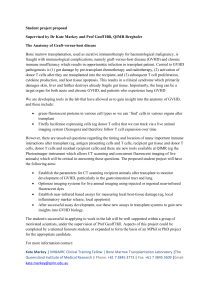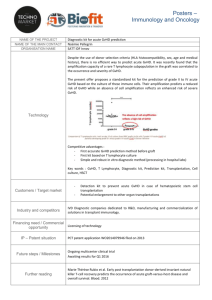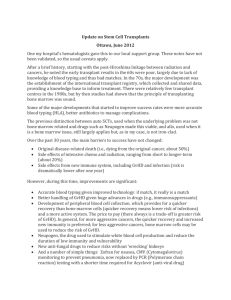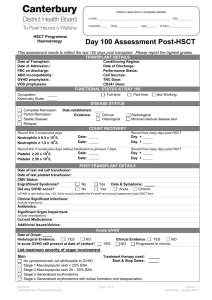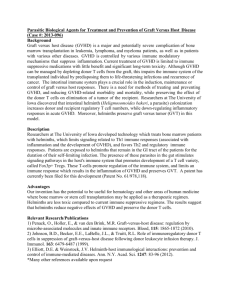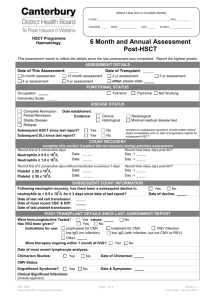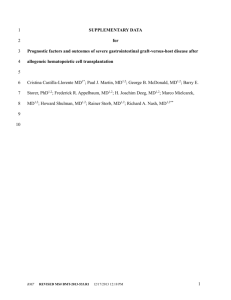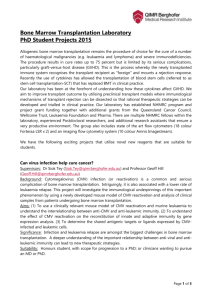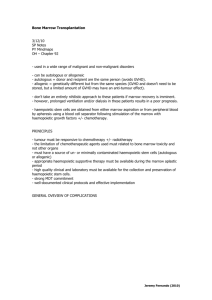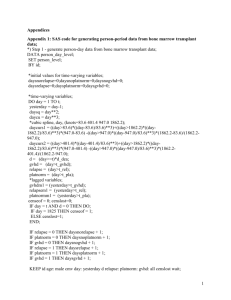Palmoplantar GVHD
advertisement
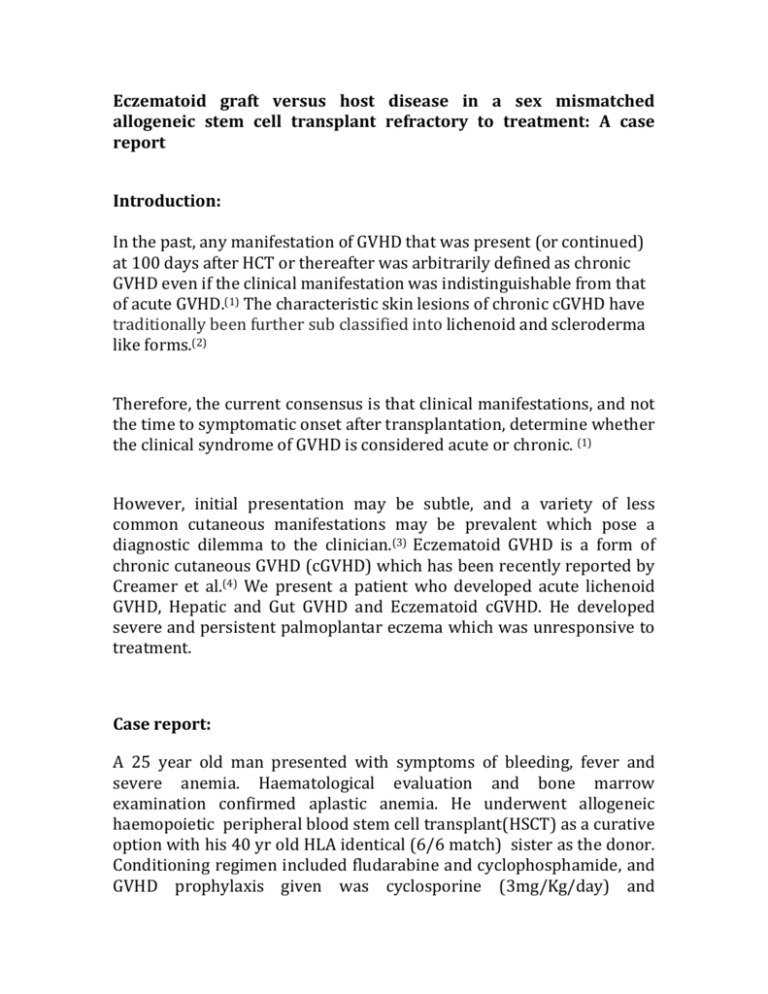
Eczematoid graft versus host disease in a sex mismatched allogeneic stem cell transplant refractory to treatment: A case report Introduction: In the past, any manifestation of GVHD that was present (or continued) at 100 days after HCT or thereafter was arbitrarily defined as chronic GVHD even if the clinical manifestation was indistinguishable from that of acute GVHD.(1) The characteristic skin lesions of chronic cGVHD have traditionally been further sub classified into lichenoid and scleroderma like forms.(2) Therefore, the current consensus is that clinical manifestations, and not the time to symptomatic onset after transplantation, determine whether the clinical syndrome of GVHD is considered acute or chronic. (1) However, initial presentation may be subtle, and a variety of less common cutaneous manifestations may be prevalent which pose a diagnostic dilemma to the clinician.(3) Eczematoid GVHD is a form of chronic cutaneous GVHD (cGVHD) which has been recently reported by Creamer et al.(4) We present a patient who developed acute lichenoid GVHD, Hepatic and Gut GVHD and Eczematoid cGVHD. He developed severe and persistent palmoplantar eczema which was unresponsive to treatment. Case report: A 25 year old man presented with symptoms of bleeding, fever and severe anemia. Haematological evaluation and bone marrow examination confirmed aplastic anemia. He underwent allogeneic haemopoietic peripheral blood stem cell transplant(HSCT) as a curative option with his 40 yr old HLA identical (6/6 match) sister as the donor. Conditioning regimen included fludarabine and cyclophosphamide, and GVHD prophylaxis given was cyclosporine (3mg/Kg/day) and methotrexate (10mg/7mg/7mg/7mg) on days 1, 3, 6 and 11). Neutrophils engrafted on day 16 and platelets on day 13. On day 80, he developed violaceous plaques with reticulate network over the buccal mucosa. There were no cutaneous lesions at that time. Nails showed pitting with longitudinal ridges. There was paronychial swelling. The biopsy from the buccal mucosa showed lymphocytic and neutrophilic exocytosis, basal cell vacuolization, satellite cell necrosis, segments of subepithelial clefting, subepithelial lichenoid and mild perivascular infiltrate of lymphocytes and neutrophils, occasional colloid bodies and pigment incontinence, suggestive of GVHD, grade 3. He was treated with oral steroids (Prednisolone 1mg/kg) along with topical tacrolimus paste (0.1%) and later oral mycofenolate mofetil was added which the patient had defaulted for 1 week prior to flaring up of the lesions. By day 108, few lichenoid papules were noted over the lips and face which gradually progressed to involve the trunk and extremities. On day 115, he developed deep seated vesicles over the lateral border of the palms and soles associated with intense itching and tenderness. These lesions soon developed into scaly,crusted plaques with oozing involving the dorsal and ventral aspects of the palms and soles. There was no personal or family history of atopy (atopic dermatitis, asthma, or eczema). He did not have similar cutaneous complaints in the past. He did not give history of seborrhoeic dermatitis or allergic contact dermatitis. There was no history of atopy in the donor. No new drugs were added in the treatment regime prior to onset of these lesions. Initially the dermatosis was controlled with topical steroids, sedating antihistamines and systemic immunosuppression (oral steroids, cyclosporine and mycofenolate). Oral antibiotics were given for secondary impetigenization. Weeping from the lesions responded to saline compresses. However, erythema and fine scaling suggestive of eczema spread over the trunk and extremities, palmo-plantar lesions became hyperkeratotic and the patient became erythrodermic within the next 10 days. He also developed ichthyotic scales over the face and scalp. At this time, PUVA therapy could not be added in view of the poor general condition of the patient. Other conditions mimicking cGVHD like drug reaction, infection and recurrent or new malignancy were excluded. On day 129, he developed features of cyclosporine induced microangiopathic hemolytic anemia, the same was stopped and oral mycophenolate was continued but the skin lesions worsened. On day 170, he presented with extensive progression of cGVHD and grade 4 hepatic GVHD (evidenced by elevated liver enzymes and bilirubin). Subsequent treatment with cyclophosphamide, sirolimus and daclizumab did not show significant response. On day 195, he succumbed to sepsis with multi-organ failure. The diagnosis of chronic cGVHD was made in view of the histopathological findings of lichenoid eruptions in the oral mucosae, lichenoid skin eruptions on the cutaneous skin, palmoplantar eczematous dermatitis and the presence of GVHD in gut and liver. This form of chronic GVHD is associated with considerable morbidity and mortality, and is refractory to treatment. It thus represents a complex management problem for both haematologists and dermatologists as it requires substantial immunosuppression to achieve control, and is associated with a poor prognosis. (4) Discussion: Chronic graft-versus-host disease (cGVHD) is the leading cause of late morbidity and mortality after allogeneic hematopoietic cell transplantation (HCT). (5) Reported incidence rates of chronic GVHD after allogeneic transplantation range from 6% to 80%. (6) According to the NIH Consensus guidelines(1), our patient had lichen planus- like changes in the oral mucosa(confirmed by biopsy) fulfilling the diagnostic criteria of chronic cGVHD even though the onset was < 100 days. The biopsy confirmd oral GVHD, grade 3. He also developed a widespread, chronic eczematous dermatitis and severe palmoplantar hyperkeratosis which was similar to that reported by Creamer et al.(4) And according to the NIH Consensus(1), our patient could be categorized into severe chronic GVHD with of score more than 3 in skin and liver and with overlap features of both chronic and acute skin GVHD. However, as per the CIBMTR classification(7) , he would belong to progressive type of chronic GVHD group as he had developed palmoplantar lesions by day 80. According to CIBMTR risk stratification(7) using 10 variables our patient had three variables (female to male transplant, prior actue GVHD, time to cGVHD <5 months). Although our patient belonged to risk group 2 with a predicated overall survival of 67% and Non relapse mortality of 20%, he succumbed to multiorgan failure and cyclosporine induced microangiopathy. Conclusion: Eczematoid GVHD is rare and difficult to treat. Early escalation of immunosuppression may be an option to prevent it from progressing to systemic GVHD. References: 1. Filipovich AH, Weisdorf D, Pavletic S, Socie G, Wingard JR, Lee SJ, et al. National Institutes of Health consensus development project on criteria for clinical trials in chronic graft-versus-host disease: I. Diagnosis and staging working group report. Biol. Blood Marrow Transplant. 2005 Dec;11(12):945–56. 2. Hymes SR, Turner ML, Champlin RE, Couriel DR. Cutaneous manifestations of chronic graft-versus-host disease. Biol. Blood Marrow Transplant. 2006 Nov;12(11):1101–13. 3. Häusermann P, Walter RB, Halter J, Biedermann BC, Tichelli A, Itin P, et al. Cutaneous graft-versus-host disease: a guide for the dermatologist. Dermatology (Basel). 2008;216(4):287–304. 4. Creamer D, Martyn-Simmons CL, Osborne G, Kenyon M, Salisbury JR, Devereux S, et al. Eczematoid graft-vs-host disease: a novel form of chronic cutaneous graft-vs-host disease and its response to psoralen UV-A therapy. Arch Dermatol. 2007 Sep;143(9):1157–62. 5. Fraser CJ, Bhatia S, Ness K, Carter A, Francisco L, Arora M, et al. Impact of chronic graft-versus-host disease on the health status of hematopoietic cell transplantation survivors: a report from the Bone Marrow Transplant Survivor Study. Blood. 2006 Oct 15;108(8):2867–73. 6. Rocha V, Wagner JE Jr, Sobocinski KA, Klein JP, Zhang MJ, Horowitz MM, et al. Graft-versus-host disease in children who have received a cord-blood or bone marrow transplant from an HLA-identical sibling. Eurocord and International Bone Marrow Transplant Registry Working Committee on Alternative Donor and Stem Cell Sources. N. Engl. J. Med. 2000 Jun 22;342(25):1846–54. 7. Arora M, Klein JP, Weisdorf DJ, Hassebroek A, Flowers MED, Cutler CS, et al. Chronic GVHD risk score: a Center for International Blood and Marrow Transplant Research analysis. Blood. 2011 Jun 16;117(24):6714–20.
